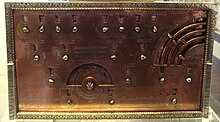
Back ضرب بالرمل Arabic Heomansya BCL Geomància Catalan Geomantie Czech Daeargoel Welsh Geomantie German Γεωμαντεία Greek Geomancio Esperanto Geomancia Spanish Geomantia Estonian
This article may be in need of reorganization to comply with Wikipedia's layout guidelines. (October 2013) |


Geomancy translates literally to "earth divination", and the term was originally used to mean methods of divination that interpret geographic features, markings on the ground, or the patterns formed by soil, rocks, or sand.[1] Its definition has expanded over time (along with the recognized definition of the suffix -mancy), to include any spiritual, metaphysical, or pseudoscientific practice that is related to the Earth. In recent times the term has been applied to a wide range of other occult and fringe activities, including Earth mysteries and the introduction of ley lines and Bau-Biologie.[citation needed]
Geomancy was one of the most popular forms of divination throughout Africa and Europe in premodern times,[2] but was considered a forbidden practice in Renaissance Europe.[2] In other regions and cultures, geomancy practices include Sikidy and Ifá (found in Africa), I Ching and Feng shui (found in China), Kumalak (found in parts of Central Asia), Vastu shastra (in India), Kahuna kuhikuhipu'uone (in Ancient Hawai'i).
- ^ “Geomancy.” Merriam-Webster.com Dictionary, Merriam-Webster, https://www.merriam-webster.com/dictionary/geomancy . Accessed 26 Jan. 2023.
- ^ a b Johannes Hartlieb (Munich, 1456) The Book of All Forbidden Arts; quoted in Láng, p. 124.